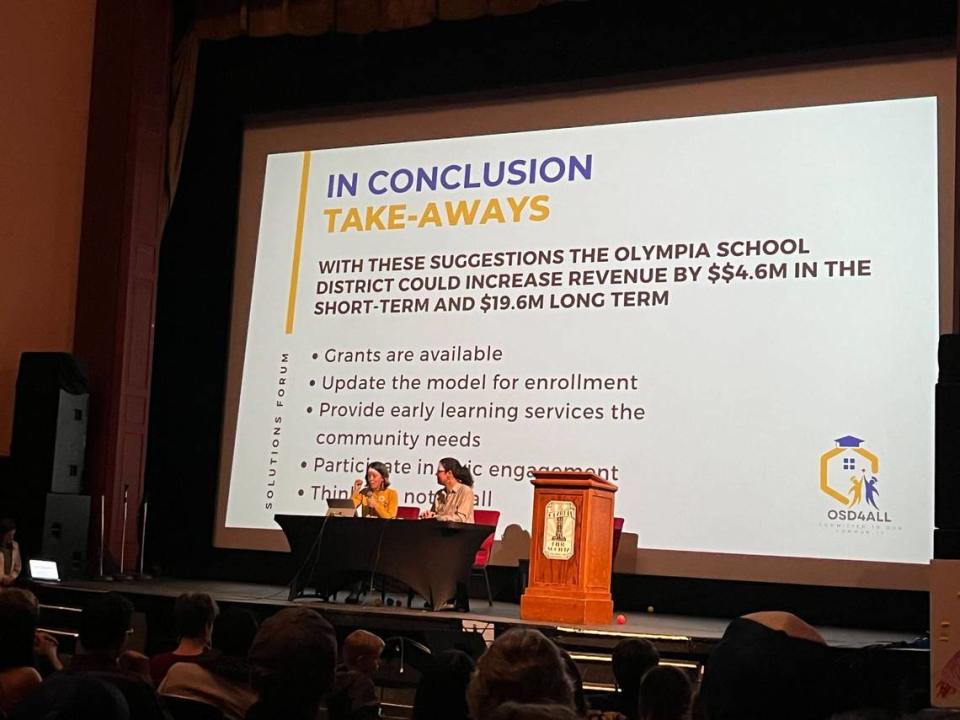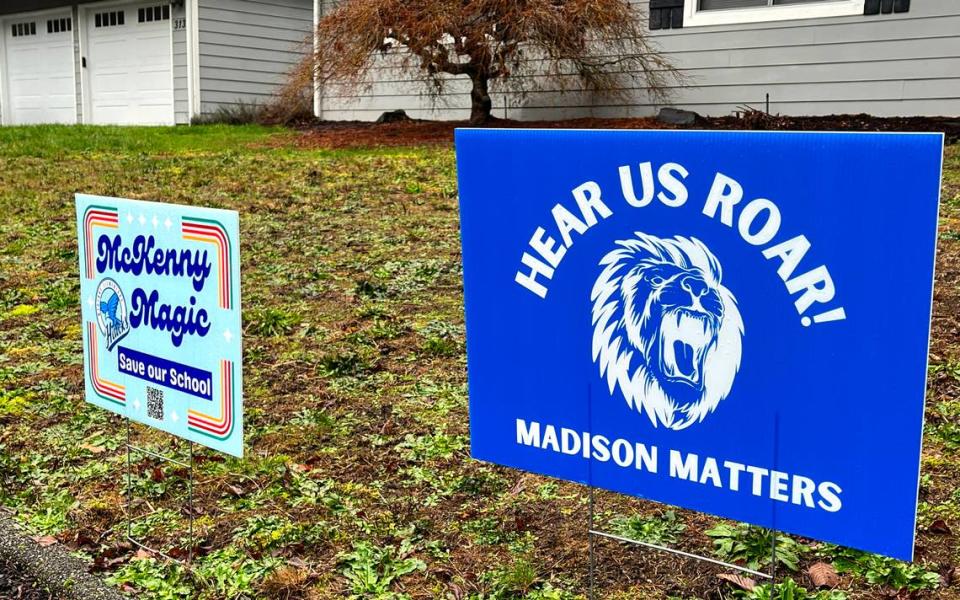Here’s what a community group suggests as alternatives to closing Olympia schools
OSD4All, a coalition of Olympia School District parents and residents, gathered Tuesday, Jan. 30, at the Capitol Theater to discuss the school district’s looming budget deficit and to consider alternatives to the district’s plan to close Madison and McKenny elementary schools to cut costs.
Presenters during the meeting, most of them parents to students whose schools are caught in the crossfire, came up with their own solutions to the $3.5 million deficit and how to stabilize the budget into the future.
Dune Ives, the PTO president for L.P. Brown Elementary on the city’s west side, began the meeting by dumping a bin of 178 brightly colored plastic balls onto the stage, saying it represented the district’s $178 million budget. She grabbed two of the balls and said they represented Madison and McKenny, a small part of the whole.
“What we know is that we can keep all schools open,” she said. “We don’t have to cut programs and services, and we can deliver a balanced budget this year. Tonight is not about ‘pie in the sky’ ideas or ‘unicorn drinks.’ Tonight is about practical solutions that will deliver real savings.”
Why we’re here
Superintendent Patrick Murphy has in the past blamed the budget deficit on the state funding formula created in response to 2017’s McCleary v. Washington decision regarding public education and local levies, the COVID-19 pandemic, and declining enrollment in the Olympia School District.
Members of OSD4All agree on the first two points, but not on the enrollment factor.
Amber Siefer, a parent, said the district’s enrollment projection model and analysis is inaccurate. She said it shows there’s a new normal enrollment decline of 100 students every year.
“Instead, the enrollment decline is much more likely a temporary setback, and because of slower economic recovery following a public health crisis, that decrease in enrollment is significantly slowing,” she said.
Siefer said in 2020 the district lost more than 400 students. But in the fall of 2023, the district only lost 26 students.
She said before the pandemic there was an average enrollment growth rate of about 1% per year. Following the pandemic, there was a steep decline of more than 4%, but Steifer said the district is recovering. In 2023, the enrollment decline was 0.3%.
Siefer said the pandemic led to fewer families moving to Olympia, which was previously a strong driver for steady enrollment growth.
She also blamed a lack of affordable single-family housing and a shift to building more multi-family housing. Steifer said there’s a strong assumption families don’t want to live in multi-family housing.
Jesse Simmons, government affairs director for Olympia Master Builders Association, said he wants to dispel both the notion about multi-family housing and the reliance enrollment has on housing in general. He said it’s a 20th century way of thinking.
Simmons said families will look at the quality of a school and the district first. He referenced a New York Times survey where more than 60% of respondents confirmed the order of planning.
Correcting the budget
Joshua Hettena, a district parent with finance experience, said the Olympia School District over budgets on a yearly basis by at least $10 million.
Hettena said on top of that, 50 employees per year leave the district voluntarily, which totals about $6 million a year. He questioned if each of those positions needs to be filled, or if the district can re-examine classroom ratios in schools and find ways to freeze half of the upcoming open positions to save $3 million.
He said the district could save another $7 million by removing some of the contingencies in revenue forecasts that lead to over budgeting. Lastly, the district could potentially save another $4 million by reducing the board’s $1 million budget, right-sizing central office support positions and reverting to the size of the 2018 administrative budget.
Local solutions
Jenne Borman, a district parent, said there’s a number of short-term federal grants the district could apply for that could provide from hundreds to millions of dollars.
Borman said OSD4All is specifically looking at the federal Impact Aid Program, which was created to reimburse school districts that have a federal presence. That includes students of military members, tribal members, federal employees, and those living in low-rent housing. The program has a second arm for students with disabilities and with the same federal qualifications.
To qualify, a district must have 400 students, or 3% of its district population, be federally connected. She said OSD4All is sending out a survey to gauge how many people in the district meet the criteria.
Kelcy Shaffer said there are a number of long-term options for bringing more revenue into the district. She started with creating an early learning program for pre-kindergarten students.
Shaffer said children who have access to early learning are less likely to repeat a grade, are more prepared academically for later grades, more likely to graduate from high school and are higher earners in the workforce.
“Early learning is also equity in action,” she said. “Access to effective, diverse programs breaks down structural barriers that have prevented all children, particularly children of color and children from disadvantaged families, from achieving their full potential.”
Shaffer said an estimated 400 students in Olympia in the 2021-2022 school year ualified for early learning. The only transitional program in the district is at Madison, which is on the chopping block.
Shaffer said if half the qualified kids were enrolled in an early learning program, it could bring in $2 million in revenue.
State changes
There’s a number of bills in the legislature this session that OSD4All is fighting for. Senate Bill 6014 would raise the special education funding cap from 15% to 17.25%, which would bring in $1.2 million.
SB 5956 would increase the maximum per-pupil limit allowed to be collected through local levies. House Bill 1244 is similar and would allow the district to collect another $1 million through local levies.
HB 2058 would make meals free for all students, and SB 5873 addresses transportation for all students, Shaffer said. SB 5882 would cut the teacher-student ratio requirement, allowing for the hiring of more non-teaching staff in public schools.
Shaffer said the OSD community also will be pushing for “regionalization” in the 2025 legislative session. Regionalization augments state funding for salaries to account for the cost of living in some districts. She said it helps districts attract and retain talent. The Olympia district has a much higher percentage of experienced teachers with higher salaries on its staff.
Pushing for a regionalization rate of 14% would bring in $15 million to Olympia.
Marissa Smith, an OSD parent, was joined on stage at the end of the meeting by other members of OSD4All while she thanked school board members Scott Clifthorne and Jess Tourtellotte-Palumbo for attending.
“We can view this as a crisis, or we can step back and we can see it as an opportunity,” she said. “We can see it as an opportunity to chart a new course, we can see it as an opportunity to succeed where other districts have failed. We can see this as an opportunity to meet our kids where they’re at in their neighborhoods, and we can see this as an opportunity to deliver a balanced budget and keep our schools open.”


